Human Resource Development: Analysis of a Learning Culture
VerifiedAdded on 2023/06/15
|10
|2228
|393
Essay
AI Summary
This essay provides an overview of learning culture within Human Resource Development (HRD), examining contemporary theories and practices for promoting it within organizations. It emphasizes the importance of learning skill development for achieving a competitive advantage in today's business environment. The essay discusses how HRD practices, including training programs, performance improvement plans, and talent management, contribute to fostering a learning culture. It highlights the role of leadership in nurturing talent and aligning organizational goals with employee development. The analysis covers key factors that enhance individual performance and emphasizes the need for continuous learning and adaptation in response to the evolving demands of the modern workplace. The paper concludes by advocating for future research focusing on advanced learning cultures and their integration with competitive advantage strategies.
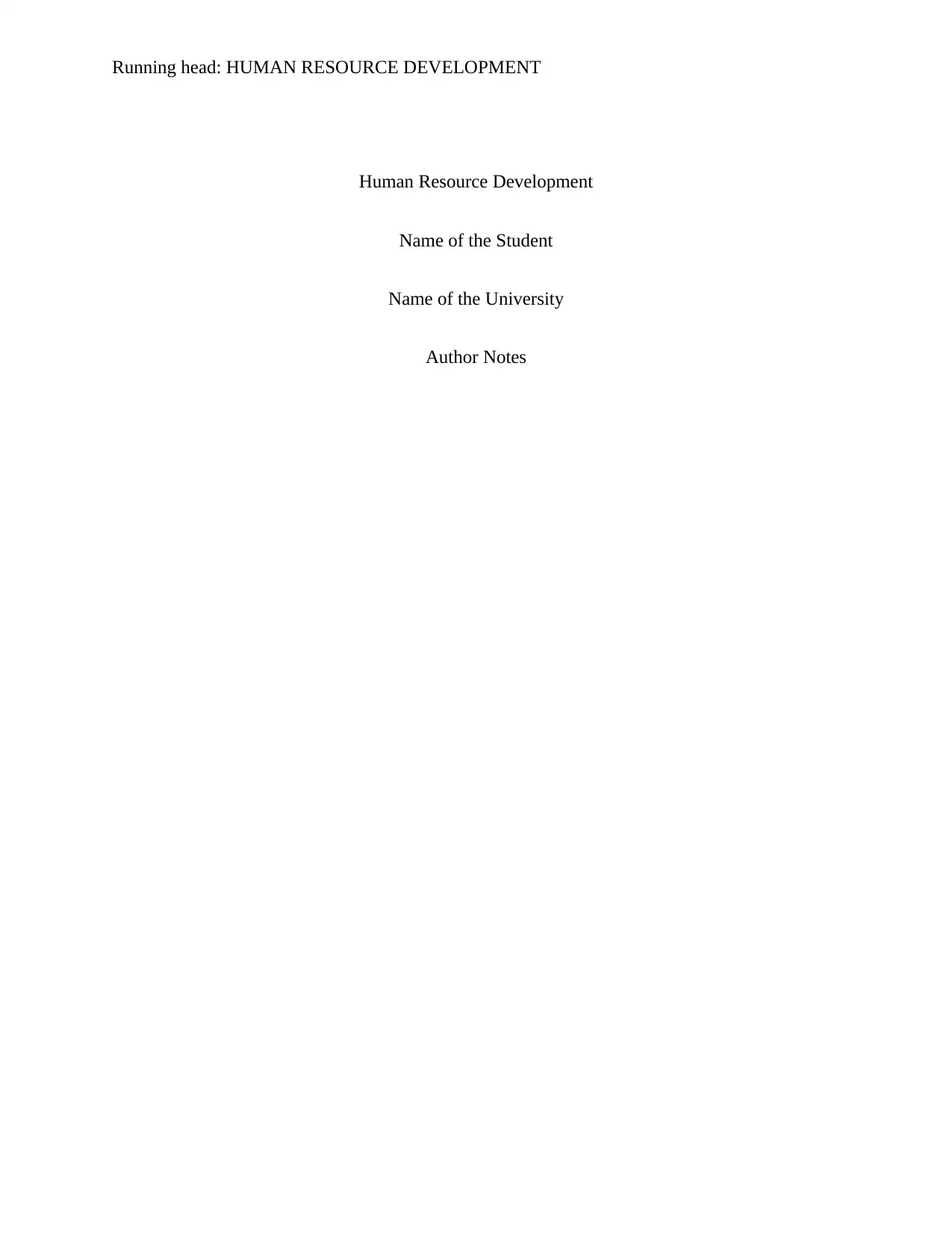
Running head: HUMAN RESOURCE DEVELOPMENT
Human Resource Development
Name of the Student
Name of the University
Author Notes
Human Resource Development
Name of the Student
Name of the University
Author Notes
Paraphrase This Document
Need a fresh take? Get an instant paraphrase of this document with our AI Paraphraser
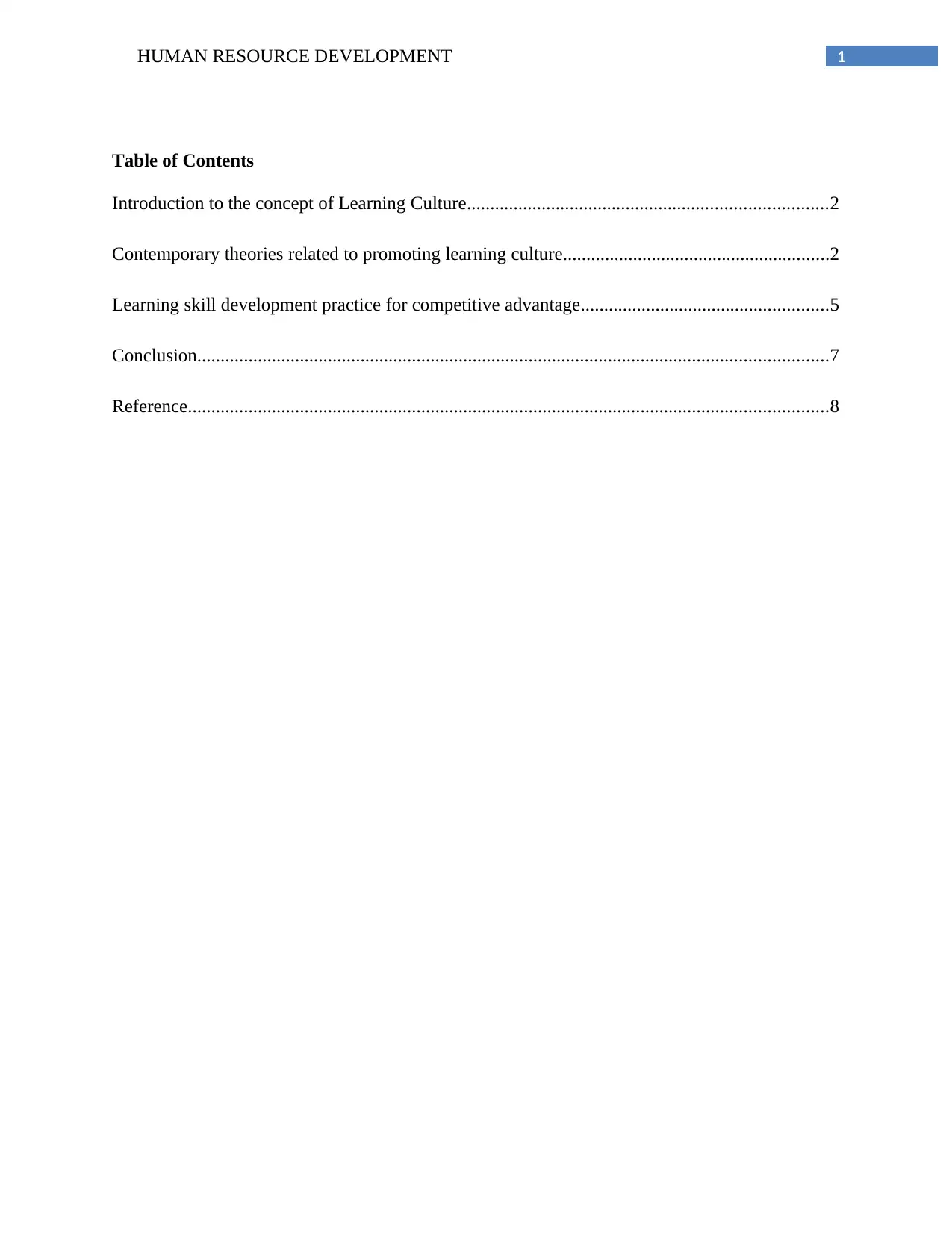
1HUMAN RESOURCE DEVELOPMENT
Table of Contents
Introduction to the concept of Learning Culture.............................................................................2
Contemporary theories related to promoting learning culture.........................................................2
Learning skill development practice for competitive advantage.....................................................5
Conclusion.......................................................................................................................................7
Reference.........................................................................................................................................8
Table of Contents
Introduction to the concept of Learning Culture.............................................................................2
Contemporary theories related to promoting learning culture.........................................................2
Learning skill development practice for competitive advantage.....................................................5
Conclusion.......................................................................................................................................7
Reference.........................................................................................................................................8
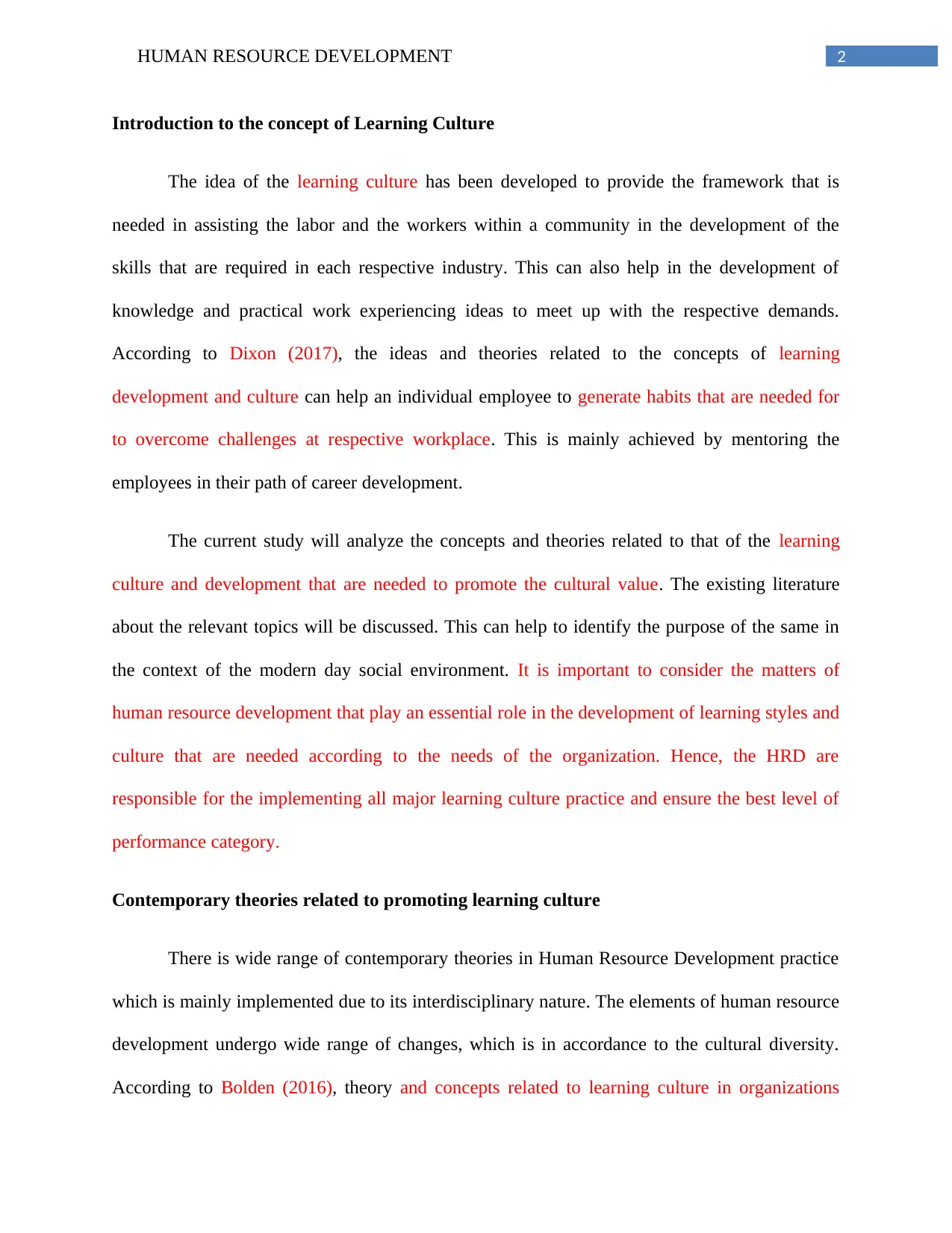
2HUMAN RESOURCE DEVELOPMENT
Introduction to the concept of Learning Culture
The idea of the learning culture has been developed to provide the framework that is
needed in assisting the labor and the workers within a community in the development of the
skills that are required in each respective industry. This can also help in the development of
knowledge and practical work experiencing ideas to meet up with the respective demands.
According to Dixon (2017), the ideas and theories related to the concepts of learning
development and culture can help an individual employee to generate habits that are needed for
to overcome challenges at respective workplace. This is mainly achieved by mentoring the
employees in their path of career development.
The current study will analyze the concepts and theories related to that of the learning
culture and development that are needed to promote the cultural value. The existing literature
about the relevant topics will be discussed. This can help to identify the purpose of the same in
the context of the modern day social environment. It is important to consider the matters of
human resource development that play an essential role in the development of learning styles and
culture that are needed according to the needs of the organization. Hence, the HRD are
responsible for the implementing all major learning culture practice and ensure the best level of
performance category.
Contemporary theories related to promoting learning culture
There is wide range of contemporary theories in Human Resource Development practice
which is mainly implemented due to its interdisciplinary nature. The elements of human resource
development undergo wide range of changes, which is in accordance to the cultural diversity.
According to Bolden (2016), theory and concepts related to learning culture in organizations
Introduction to the concept of Learning Culture
The idea of the learning culture has been developed to provide the framework that is
needed in assisting the labor and the workers within a community in the development of the
skills that are required in each respective industry. This can also help in the development of
knowledge and practical work experiencing ideas to meet up with the respective demands.
According to Dixon (2017), the ideas and theories related to the concepts of learning
development and culture can help an individual employee to generate habits that are needed for
to overcome challenges at respective workplace. This is mainly achieved by mentoring the
employees in their path of career development.
The current study will analyze the concepts and theories related to that of the learning
culture and development that are needed to promote the cultural value. The existing literature
about the relevant topics will be discussed. This can help to identify the purpose of the same in
the context of the modern day social environment. It is important to consider the matters of
human resource development that play an essential role in the development of learning styles and
culture that are needed according to the needs of the organization. Hence, the HRD are
responsible for the implementing all major learning culture practice and ensure the best level of
performance category.
Contemporary theories related to promoting learning culture
There is wide range of contemporary theories in Human Resource Development practice
which is mainly implemented due to its interdisciplinary nature. The elements of human resource
development undergo wide range of changes, which is in accordance to the cultural diversity.
According to Bolden (2016), theory and concepts related to learning culture in organizations
⊘ This is a preview!⊘
Do you want full access?
Subscribe today to unlock all pages.

Trusted by 1+ million students worldwide
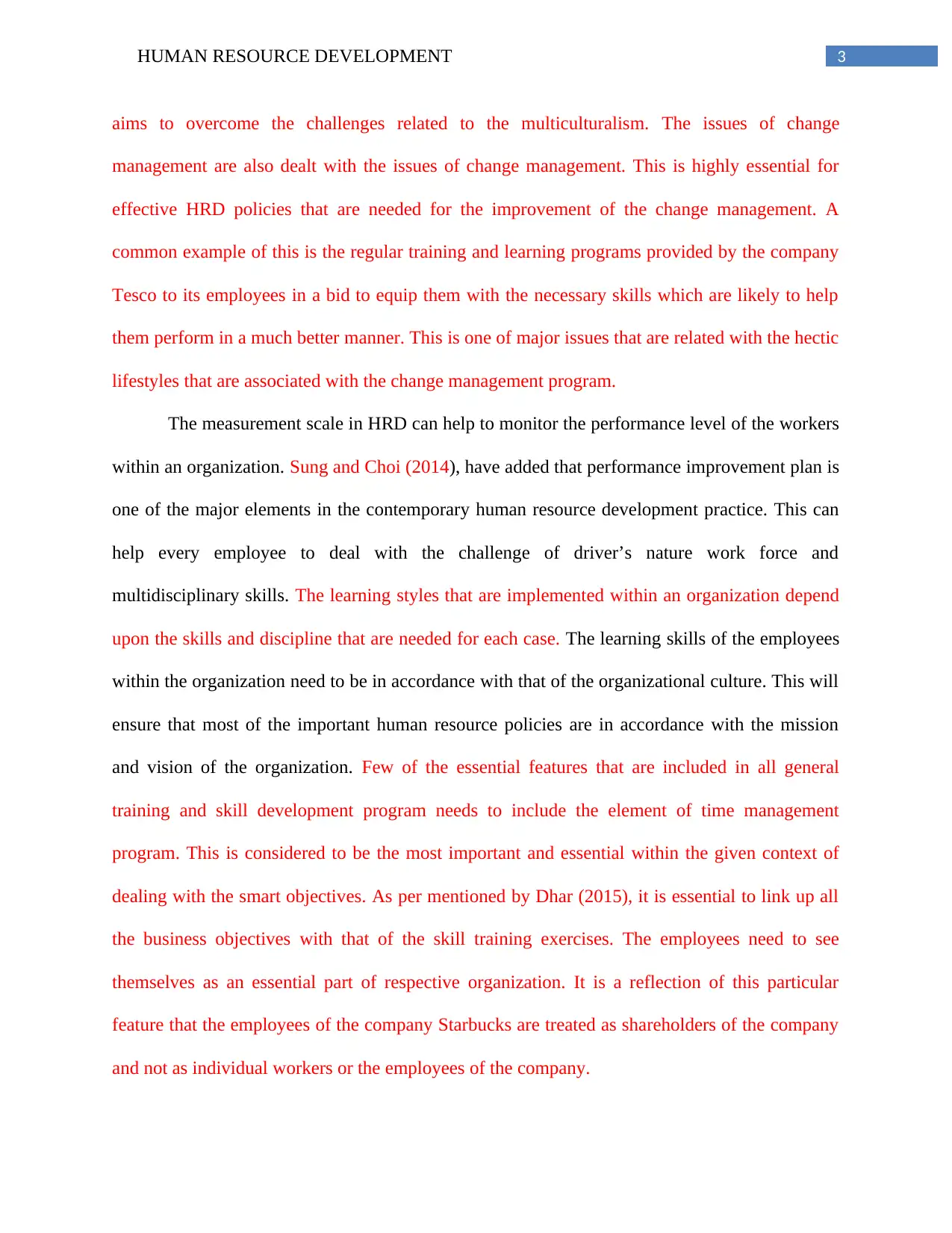
3HUMAN RESOURCE DEVELOPMENT
aims to overcome the challenges related to the multiculturalism. The issues of change
management are also dealt with the issues of change management. This is highly essential for
effective HRD policies that are needed for the improvement of the change management. A
common example of this is the regular training and learning programs provided by the company
Tesco to its employees in a bid to equip them with the necessary skills which are likely to help
them perform in a much better manner. This is one of major issues that are related with the hectic
lifestyles that are associated with the change management program.
The measurement scale in HRD can help to monitor the performance level of the workers
within an organization. Sung and Choi (2014), have added that performance improvement plan is
one of the major elements in the contemporary human resource development practice. This can
help every employee to deal with the challenge of driver’s nature work force and
multidisciplinary skills. The learning styles that are implemented within an organization depend
upon the skills and discipline that are needed for each case. The learning skills of the employees
within the organization need to be in accordance with that of the organizational culture. This will
ensure that most of the important human resource policies are in accordance with the mission
and vision of the organization. Few of the essential features that are included in all general
training and skill development program needs to include the element of time management
program. This is considered to be the most important and essential within the given context of
dealing with the smart objectives. As per mentioned by Dhar (2015), it is essential to link up all
the business objectives with that of the skill training exercises. The employees need to see
themselves as an essential part of respective organization. It is a reflection of this particular
feature that the employees of the company Starbucks are treated as shareholders of the company
and not as individual workers or the employees of the company.
aims to overcome the challenges related to the multiculturalism. The issues of change
management are also dealt with the issues of change management. This is highly essential for
effective HRD policies that are needed for the improvement of the change management. A
common example of this is the regular training and learning programs provided by the company
Tesco to its employees in a bid to equip them with the necessary skills which are likely to help
them perform in a much better manner. This is one of major issues that are related with the hectic
lifestyles that are associated with the change management program.
The measurement scale in HRD can help to monitor the performance level of the workers
within an organization. Sung and Choi (2014), have added that performance improvement plan is
one of the major elements in the contemporary human resource development practice. This can
help every employee to deal with the challenge of driver’s nature work force and
multidisciplinary skills. The learning styles that are implemented within an organization depend
upon the skills and discipline that are needed for each case. The learning skills of the employees
within the organization need to be in accordance with that of the organizational culture. This will
ensure that most of the important human resource policies are in accordance with the mission
and vision of the organization. Few of the essential features that are included in all general
training and skill development program needs to include the element of time management
program. This is considered to be the most important and essential within the given context of
dealing with the smart objectives. As per mentioned by Dhar (2015), it is essential to link up all
the business objectives with that of the skill training exercises. The employees need to see
themselves as an essential part of respective organization. It is a reflection of this particular
feature that the employees of the company Starbucks are treated as shareholders of the company
and not as individual workers or the employees of the company.
Paraphrase This Document
Need a fresh take? Get an instant paraphrase of this document with our AI Paraphraser
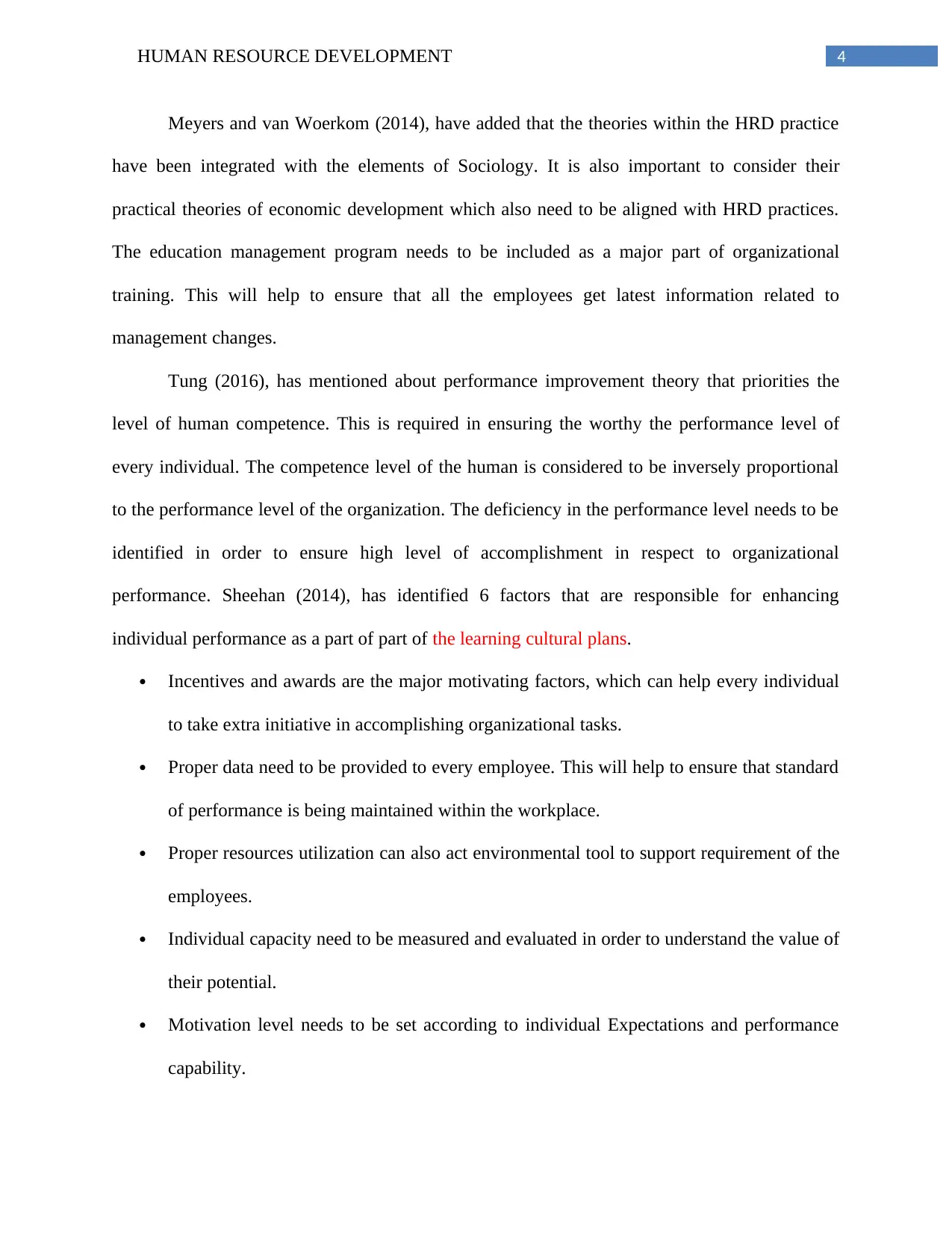
4HUMAN RESOURCE DEVELOPMENT
Meyers and van Woerkom (2014), have added that the theories within the HRD practice
have been integrated with the elements of Sociology. It is also important to consider their
practical theories of economic development which also need to be aligned with HRD practices.
The education management program needs to be included as a major part of organizational
training. This will help to ensure that all the employees get latest information related to
management changes.
Tung (2016), has mentioned about performance improvement theory that priorities the
level of human competence. This is required in ensuring the worthy the performance level of
every individual. The competence level of the human is considered to be inversely proportional
to the performance level of the organization. The deficiency in the performance level needs to be
identified in order to ensure high level of accomplishment in respect to organizational
performance. Sheehan (2014), has identified 6 factors that are responsible for enhancing
individual performance as a part of part of the learning cultural plans.
Incentives and awards are the major motivating factors, which can help every individual
to take extra initiative in accomplishing organizational tasks.
Proper data need to be provided to every employee. This will help to ensure that standard
of performance is being maintained within the workplace.
Proper resources utilization can also act environmental tool to support requirement of the
employees.
Individual capacity need to be measured and evaluated in order to understand the value of
their potential.
Motivation level needs to be set according to individual Expectations and performance
capability.
Meyers and van Woerkom (2014), have added that the theories within the HRD practice
have been integrated with the elements of Sociology. It is also important to consider their
practical theories of economic development which also need to be aligned with HRD practices.
The education management program needs to be included as a major part of organizational
training. This will help to ensure that all the employees get latest information related to
management changes.
Tung (2016), has mentioned about performance improvement theory that priorities the
level of human competence. This is required in ensuring the worthy the performance level of
every individual. The competence level of the human is considered to be inversely proportional
to the performance level of the organization. The deficiency in the performance level needs to be
identified in order to ensure high level of accomplishment in respect to organizational
performance. Sheehan (2014), has identified 6 factors that are responsible for enhancing
individual performance as a part of part of the learning cultural plans.
Incentives and awards are the major motivating factors, which can help every individual
to take extra initiative in accomplishing organizational tasks.
Proper data need to be provided to every employee. This will help to ensure that standard
of performance is being maintained within the workplace.
Proper resources utilization can also act environmental tool to support requirement of the
employees.
Individual capacity need to be measured and evaluated in order to understand the value of
their potential.
Motivation level needs to be set according to individual Expectations and performance
capability.
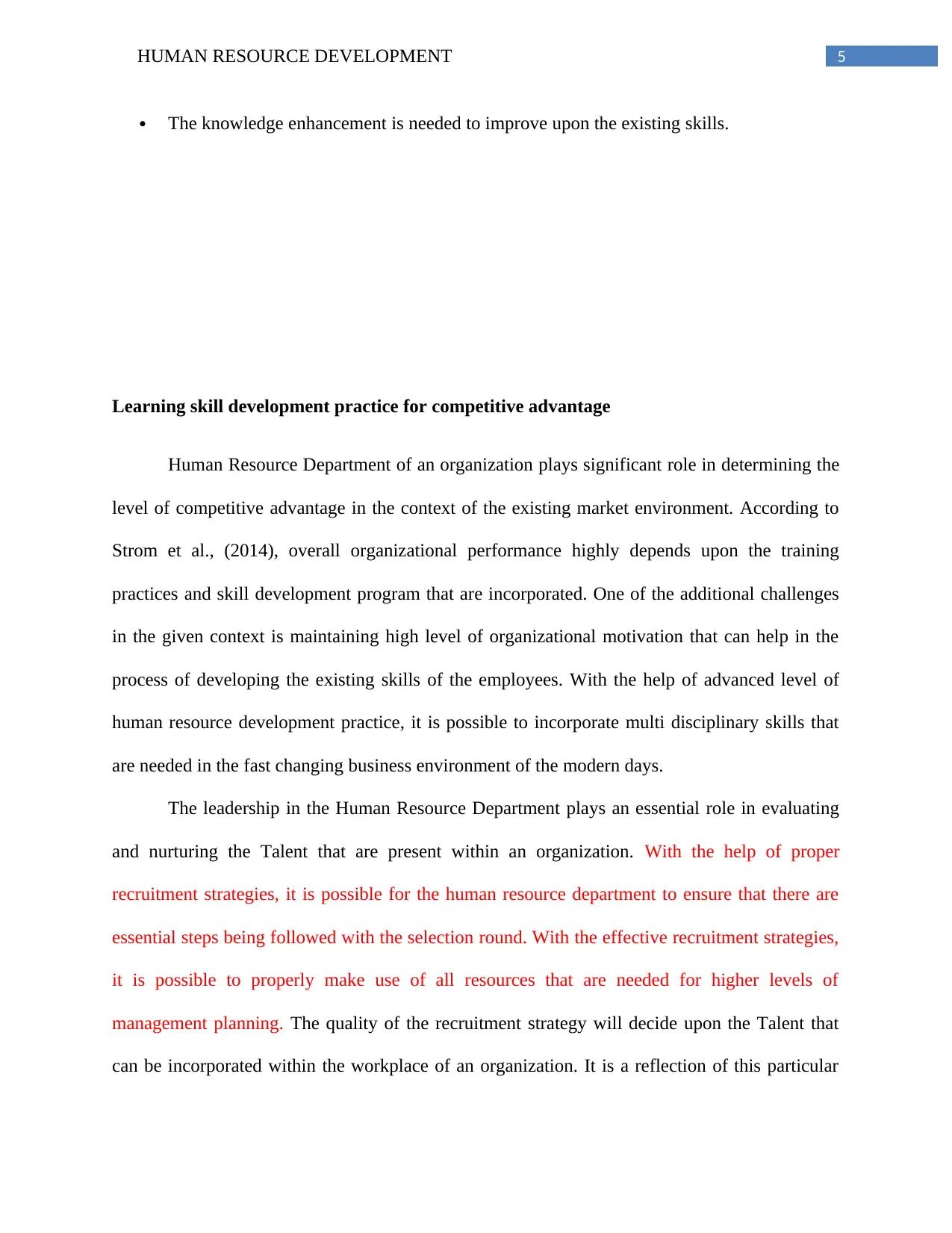
5HUMAN RESOURCE DEVELOPMENT
The knowledge enhancement is needed to improve upon the existing skills.
Learning skill development practice for competitive advantage
Human Resource Department of an organization plays significant role in determining the
level of competitive advantage in the context of the existing market environment. According to
Strom et al., (2014), overall organizational performance highly depends upon the training
practices and skill development program that are incorporated. One of the additional challenges
in the given context is maintaining high level of organizational motivation that can help in the
process of developing the existing skills of the employees. With the help of advanced level of
human resource development practice, it is possible to incorporate multi disciplinary skills that
are needed in the fast changing business environment of the modern days.
The leadership in the Human Resource Department plays an essential role in evaluating
and nurturing the Talent that are present within an organization. With the help of proper
recruitment strategies, it is possible for the human resource department to ensure that there are
essential steps being followed with the selection round. With the effective recruitment strategies,
it is possible to properly make use of all resources that are needed for higher levels of
management planning. The quality of the recruitment strategy will decide upon the Talent that
can be incorporated within the workplace of an organization. It is a reflection of this particular
The knowledge enhancement is needed to improve upon the existing skills.
Learning skill development practice for competitive advantage
Human Resource Department of an organization plays significant role in determining the
level of competitive advantage in the context of the existing market environment. According to
Strom et al., (2014), overall organizational performance highly depends upon the training
practices and skill development program that are incorporated. One of the additional challenges
in the given context is maintaining high level of organizational motivation that can help in the
process of developing the existing skills of the employees. With the help of advanced level of
human resource development practice, it is possible to incorporate multi disciplinary skills that
are needed in the fast changing business environment of the modern days.
The leadership in the Human Resource Department plays an essential role in evaluating
and nurturing the Talent that are present within an organization. With the help of proper
recruitment strategies, it is possible for the human resource department to ensure that there are
essential steps being followed with the selection round. With the effective recruitment strategies,
it is possible to properly make use of all resources that are needed for higher levels of
management planning. The quality of the recruitment strategy will decide upon the Talent that
can be incorporated within the workplace of an organization. It is a reflection of this particular
⊘ This is a preview!⊘
Do you want full access?
Subscribe today to unlock all pages.

Trusted by 1+ million students worldwide
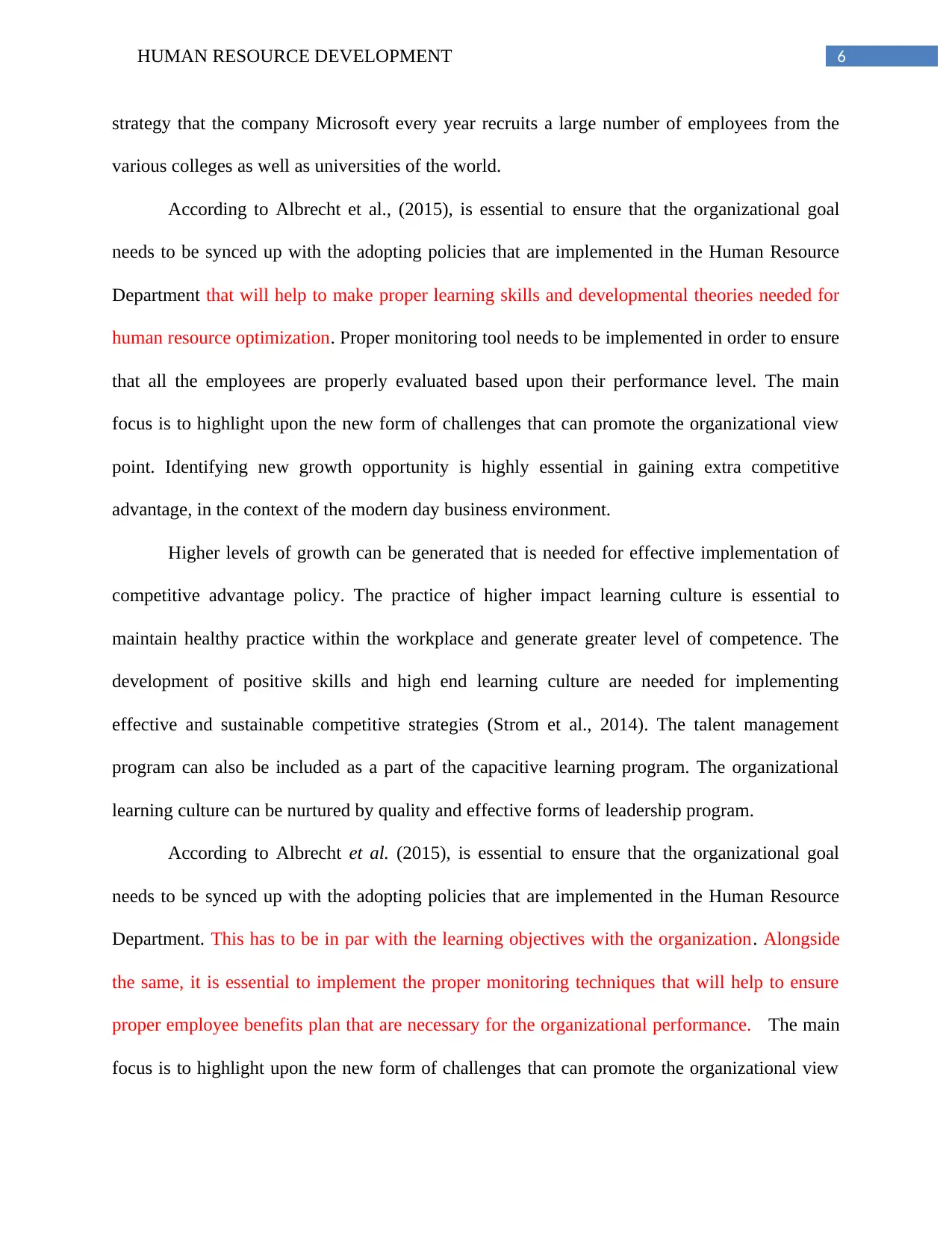
6HUMAN RESOURCE DEVELOPMENT
strategy that the company Microsoft every year recruits a large number of employees from the
various colleges as well as universities of the world.
According to Albrecht et al., (2015), is essential to ensure that the organizational goal
needs to be synced up with the adopting policies that are implemented in the Human Resource
Department that will help to make proper learning skills and developmental theories needed for
human resource optimization. Proper monitoring tool needs to be implemented in order to ensure
that all the employees are properly evaluated based upon their performance level. The main
focus is to highlight upon the new form of challenges that can promote the organizational view
point. Identifying new growth opportunity is highly essential in gaining extra competitive
advantage, in the context of the modern day business environment.
Higher levels of growth can be generated that is needed for effective implementation of
competitive advantage policy. The practice of higher impact learning culture is essential to
maintain healthy practice within the workplace and generate greater level of competence. The
development of positive skills and high end learning culture are needed for implementing
effective and sustainable competitive strategies (Strom et al., 2014). The talent management
program can also be included as a part of the capacitive learning program. The organizational
learning culture can be nurtured by quality and effective forms of leadership program.
According to Albrecht et al. (2015), is essential to ensure that the organizational goal
needs to be synced up with the adopting policies that are implemented in the Human Resource
Department. This has to be in par with the learning objectives with the organization. Alongside
the same, it is essential to implement the proper monitoring techniques that will help to ensure
proper employee benefits plan that are necessary for the organizational performance. The main
focus is to highlight upon the new form of challenges that can promote the organizational view
strategy that the company Microsoft every year recruits a large number of employees from the
various colleges as well as universities of the world.
According to Albrecht et al., (2015), is essential to ensure that the organizational goal
needs to be synced up with the adopting policies that are implemented in the Human Resource
Department that will help to make proper learning skills and developmental theories needed for
human resource optimization. Proper monitoring tool needs to be implemented in order to ensure
that all the employees are properly evaluated based upon their performance level. The main
focus is to highlight upon the new form of challenges that can promote the organizational view
point. Identifying new growth opportunity is highly essential in gaining extra competitive
advantage, in the context of the modern day business environment.
Higher levels of growth can be generated that is needed for effective implementation of
competitive advantage policy. The practice of higher impact learning culture is essential to
maintain healthy practice within the workplace and generate greater level of competence. The
development of positive skills and high end learning culture are needed for implementing
effective and sustainable competitive strategies (Strom et al., 2014). The talent management
program can also be included as a part of the capacitive learning program. The organizational
learning culture can be nurtured by quality and effective forms of leadership program.
According to Albrecht et al. (2015), is essential to ensure that the organizational goal
needs to be synced up with the adopting policies that are implemented in the Human Resource
Department. This has to be in par with the learning objectives with the organization. Alongside
the same, it is essential to implement the proper monitoring techniques that will help to ensure
proper employee benefits plan that are necessary for the organizational performance. The main
focus is to highlight upon the new form of challenges that can promote the organizational view
Paraphrase This Document
Need a fresh take? Get an instant paraphrase of this document with our AI Paraphraser
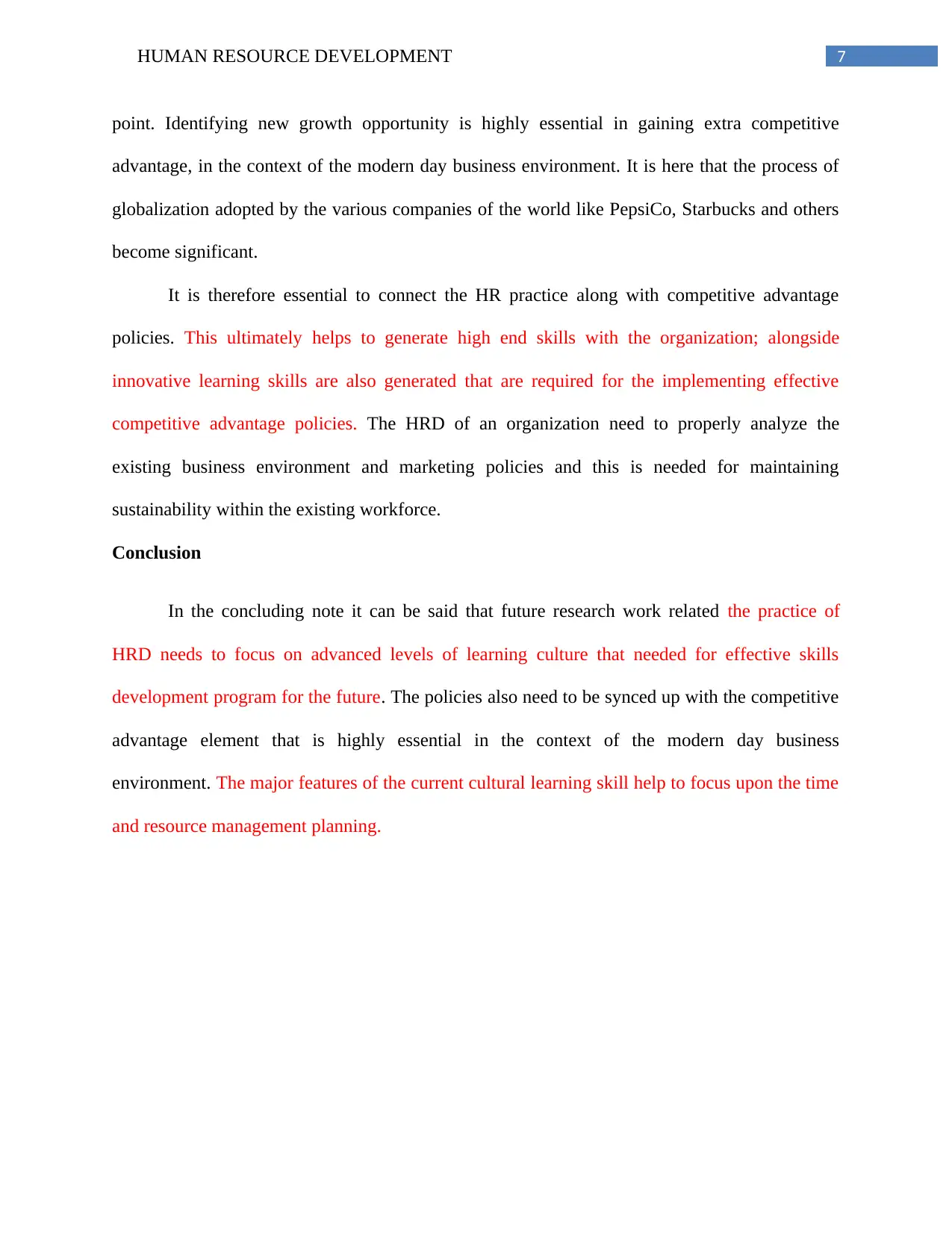
7HUMAN RESOURCE DEVELOPMENT
point. Identifying new growth opportunity is highly essential in gaining extra competitive
advantage, in the context of the modern day business environment. It is here that the process of
globalization adopted by the various companies of the world like PepsiCo, Starbucks and others
become significant.
It is therefore essential to connect the HR practice along with competitive advantage
policies. This ultimately helps to generate high end skills with the organization; alongside
innovative learning skills are also generated that are required for the implementing effective
competitive advantage policies. The HRD of an organization need to properly analyze the
existing business environment and marketing policies and this is needed for maintaining
sustainability within the existing workforce.
Conclusion
In the concluding note it can be said that future research work related the practice of
HRD needs to focus on advanced levels of learning culture that needed for effective skills
development program for the future. The policies also need to be synced up with the competitive
advantage element that is highly essential in the context of the modern day business
environment. The major features of the current cultural learning skill help to focus upon the time
and resource management planning.
point. Identifying new growth opportunity is highly essential in gaining extra competitive
advantage, in the context of the modern day business environment. It is here that the process of
globalization adopted by the various companies of the world like PepsiCo, Starbucks and others
become significant.
It is therefore essential to connect the HR practice along with competitive advantage
policies. This ultimately helps to generate high end skills with the organization; alongside
innovative learning skills are also generated that are required for the implementing effective
competitive advantage policies. The HRD of an organization need to properly analyze the
existing business environment and marketing policies and this is needed for maintaining
sustainability within the existing workforce.
Conclusion
In the concluding note it can be said that future research work related the practice of
HRD needs to focus on advanced levels of learning culture that needed for effective skills
development program for the future. The policies also need to be synced up with the competitive
advantage element that is highly essential in the context of the modern day business
environment. The major features of the current cultural learning skill help to focus upon the time
and resource management planning.
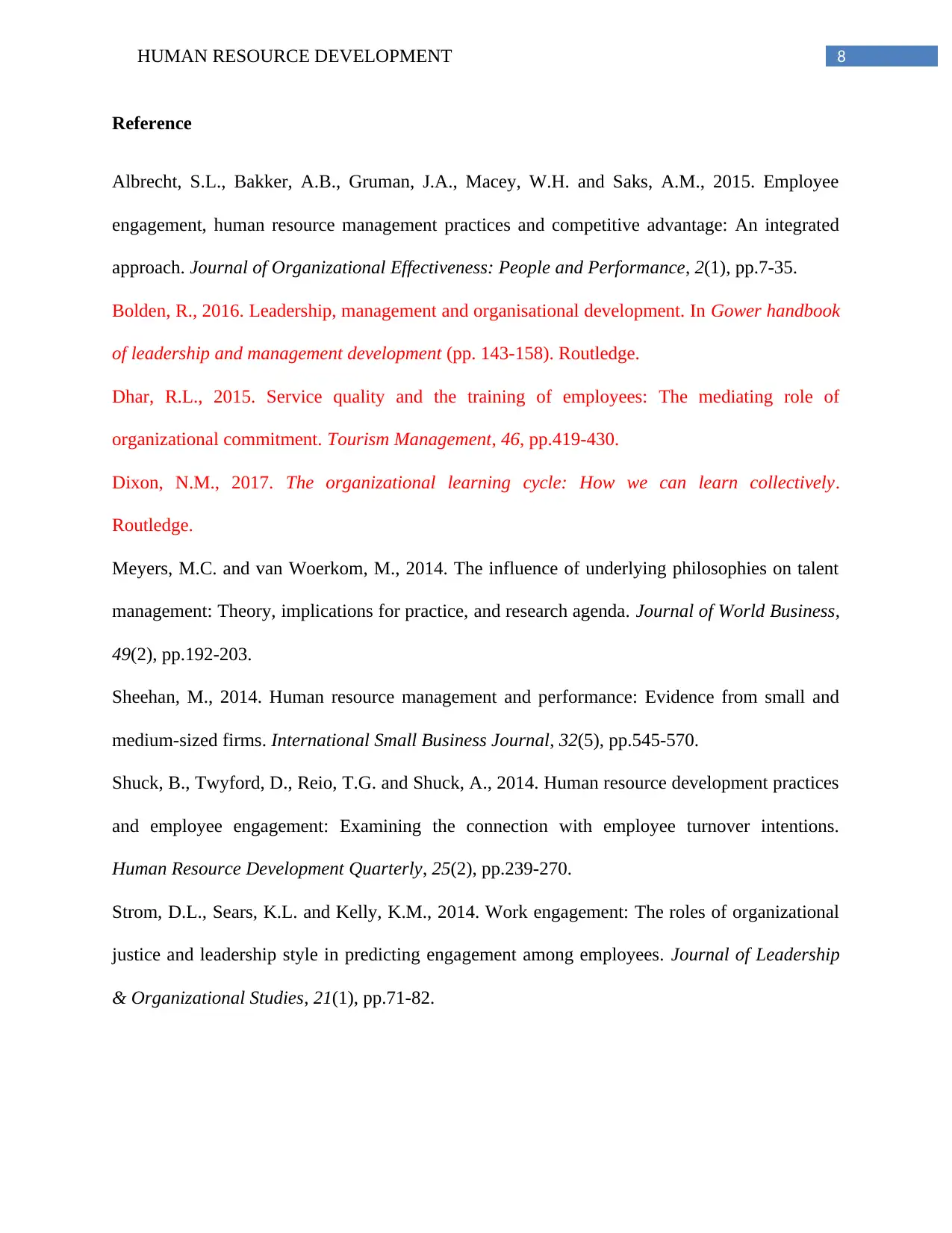
8HUMAN RESOURCE DEVELOPMENT
Reference
Albrecht, S.L., Bakker, A.B., Gruman, J.A., Macey, W.H. and Saks, A.M., 2015. Employee
engagement, human resource management practices and competitive advantage: An integrated
approach. Journal of Organizational Effectiveness: People and Performance, 2(1), pp.7-35.
Bolden, R., 2016. Leadership, management and organisational development. In Gower handbook
of leadership and management development (pp. 143-158). Routledge.
Dhar, R.L., 2015. Service quality and the training of employees: The mediating role of
organizational commitment. Tourism Management, 46, pp.419-430.
Dixon, N.M., 2017. The organizational learning cycle: How we can learn collectively.
Routledge.
Meyers, M.C. and van Woerkom, M., 2014. The influence of underlying philosophies on talent
management: Theory, implications for practice, and research agenda. Journal of World Business,
49(2), pp.192-203.
Sheehan, M., 2014. Human resource management and performance: Evidence from small and
medium-sized firms. International Small Business Journal, 32(5), pp.545-570.
Shuck, B., Twyford, D., Reio, T.G. and Shuck, A., 2014. Human resource development practices
and employee engagement: Examining the connection with employee turnover intentions.
Human Resource Development Quarterly, 25(2), pp.239-270.
Strom, D.L., Sears, K.L. and Kelly, K.M., 2014. Work engagement: The roles of organizational
justice and leadership style in predicting engagement among employees. Journal of Leadership
& Organizational Studies, 21(1), pp.71-82.
Reference
Albrecht, S.L., Bakker, A.B., Gruman, J.A., Macey, W.H. and Saks, A.M., 2015. Employee
engagement, human resource management practices and competitive advantage: An integrated
approach. Journal of Organizational Effectiveness: People and Performance, 2(1), pp.7-35.
Bolden, R., 2016. Leadership, management and organisational development. In Gower handbook
of leadership and management development (pp. 143-158). Routledge.
Dhar, R.L., 2015. Service quality and the training of employees: The mediating role of
organizational commitment. Tourism Management, 46, pp.419-430.
Dixon, N.M., 2017. The organizational learning cycle: How we can learn collectively.
Routledge.
Meyers, M.C. and van Woerkom, M., 2014. The influence of underlying philosophies on talent
management: Theory, implications for practice, and research agenda. Journal of World Business,
49(2), pp.192-203.
Sheehan, M., 2014. Human resource management and performance: Evidence from small and
medium-sized firms. International Small Business Journal, 32(5), pp.545-570.
Shuck, B., Twyford, D., Reio, T.G. and Shuck, A., 2014. Human resource development practices
and employee engagement: Examining the connection with employee turnover intentions.
Human Resource Development Quarterly, 25(2), pp.239-270.
Strom, D.L., Sears, K.L. and Kelly, K.M., 2014. Work engagement: The roles of organizational
justice and leadership style in predicting engagement among employees. Journal of Leadership
& Organizational Studies, 21(1), pp.71-82.
⊘ This is a preview!⊘
Do you want full access?
Subscribe today to unlock all pages.

Trusted by 1+ million students worldwide
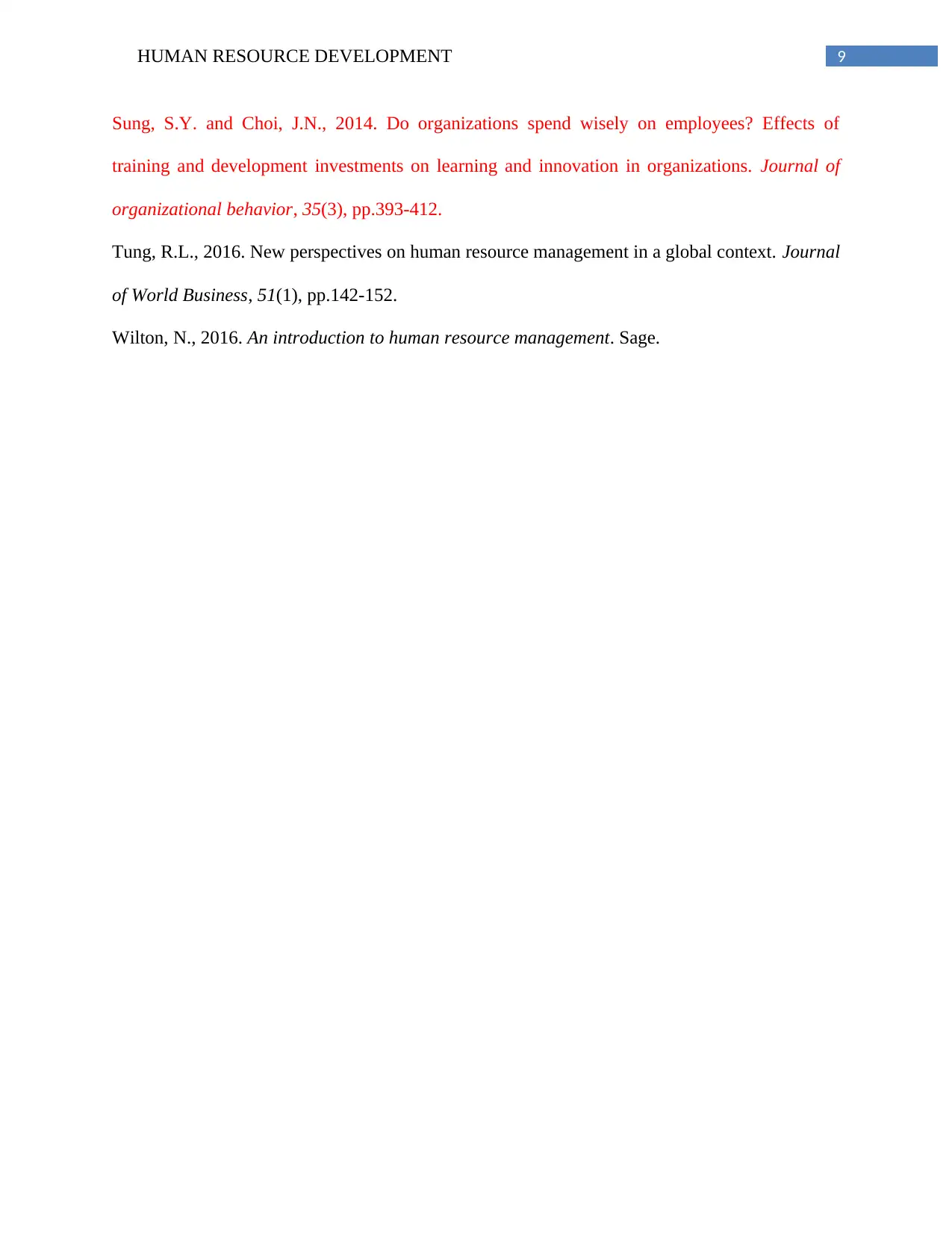
9HUMAN RESOURCE DEVELOPMENT
Sung, S.Y. and Choi, J.N., 2014. Do organizations spend wisely on employees? Effects of
training and development investments on learning and innovation in organizations. Journal of
organizational behavior, 35(3), pp.393-412.
Tung, R.L., 2016. New perspectives on human resource management in a global context. Journal
of World Business, 51(1), pp.142-152.
Wilton, N., 2016. An introduction to human resource management. Sage.
Sung, S.Y. and Choi, J.N., 2014. Do organizations spend wisely on employees? Effects of
training and development investments on learning and innovation in organizations. Journal of
organizational behavior, 35(3), pp.393-412.
Tung, R.L., 2016. New perspectives on human resource management in a global context. Journal
of World Business, 51(1), pp.142-152.
Wilton, N., 2016. An introduction to human resource management. Sage.
1 out of 10
Related Documents
Your All-in-One AI-Powered Toolkit for Academic Success.
+13062052269
info@desklib.com
Available 24*7 on WhatsApp / Email
![[object Object]](/_next/static/media/star-bottom.7253800d.svg)
Unlock your academic potential
Copyright © 2020–2025 A2Z Services. All Rights Reserved. Developed and managed by ZUCOL.





